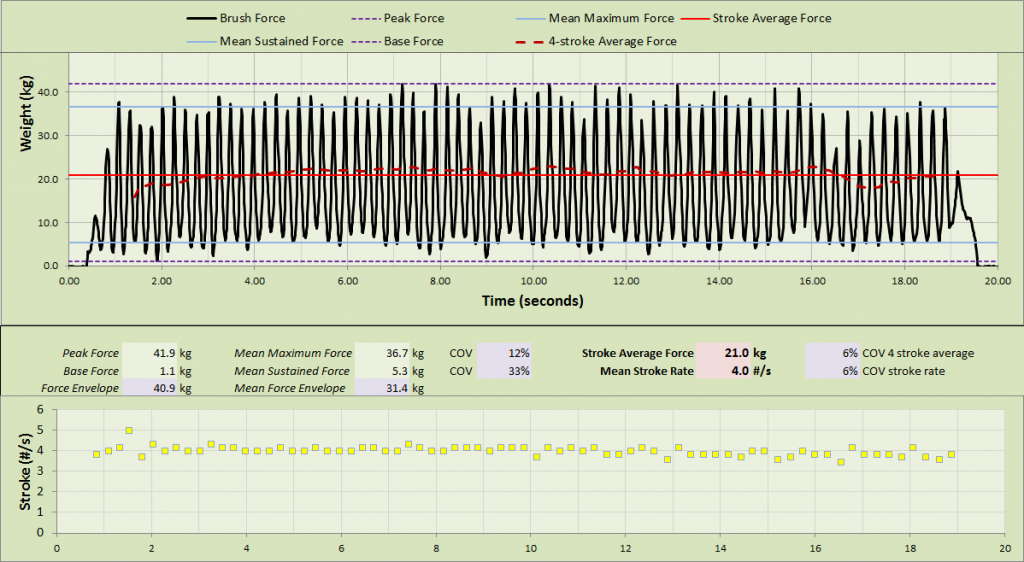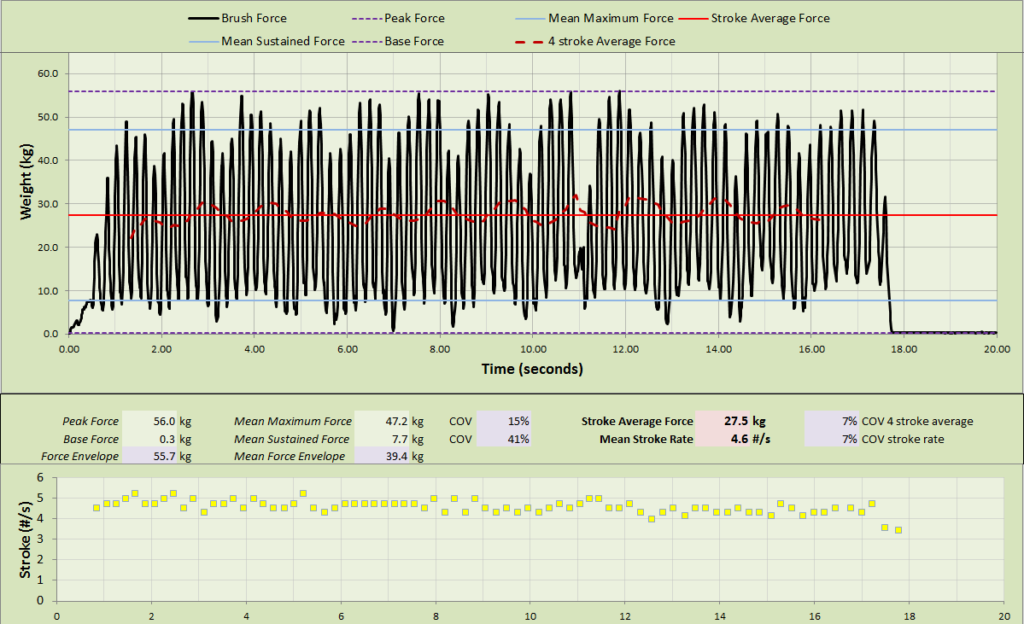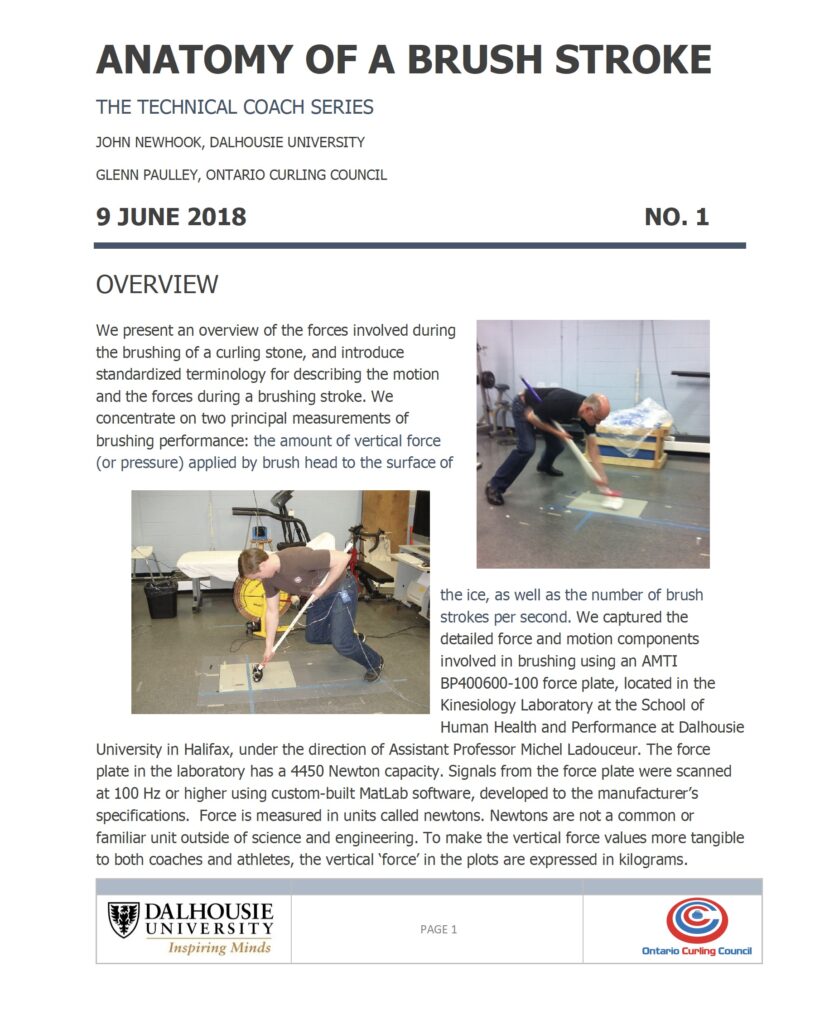This article is joint work with Professor of Engineering John Newhook of Dalhousie University in Halifax.
In 2018 we documented the vertical forces and other characteristics of a brush stroke in order to better convey our understanding of the mechanics of brushing and how we might use this information to improve the coaching of the sport.
This article, the first in our Technical Coach Series, is certainly not the first to document the variability in the forces achieved when brushing. To our knowledge, it would appear that researchers in the School of Engineering at the University of Edinburgh (B.A. Marmo, I.S. Farrow, M-P Buckingham, and J.R. Blackford) were the first to document the variability of forces during a brush stroke, and how these forces are generated on the ice, in various papers in 2005-2006 (see references below). Their results were later confirmed by other researchers in 2010-2012 in both Canada and in Japan, and potentially in other countries.
What we present in this first document of our Technical Series is confirmation of the pattern of vertical forces involved in brushing (though with much greater force, typical of top athletes) and describe the forces involved in more detail. We also define some terminology to help describe precisely the specific characteristics of a stroke.
Forces in a single brush stroke
The graphic at right illustrates the vertical forces involved during a single complete brush stroke, with the force measure converted from newtons to the more familiar kilograms to aid in understanding. In this example, the athlete is standing at the right side of the graph; the brush horizontal position is measured from the left-hand side of the force plate.

We captured the detailed force and motion components involved in brushing using an AMTI BP400600-100 force plate, located in the Kinesiology Laboratory at the School of Human Health and Performance at Dalhousie University in Halifax, under the direction of Assistant Professor Michel Ladouceur.
The graphic illustrates the production of vertical force during a single stroke. Immediately upon the initiation of the “push” portion of the stroke (dark blue arrow) the amount of vertical force applied through the brush handle increases significantly, in this case by also 50%, to reach a peak of approximately 65 kg. Through the remaining movement away from the athlete’s feet (light blue arrow), the vertical force drops significantly to 10 kg at the point where the brush is furthest from the feet of the athlete, and the athlete initiates the “pull” portion of the stroke. At the beginning of this phase, the vertical force drops to a low of about 6 kg, and then climbs through the remainder of the “pull” portion of the stroke (orange dots) until the brush head movement will again transition to the “push”, at a point just greater than 40 kg.
In this example, the stroke displacement, or the distance the brush head travels in one direction, is about 20 cm or 8 inches. The thing to realize is that after just 10 cm of movement, the vertical force on the brush during the “push” portion of the stroke has dropped a full 50%. This has obvious implications; the precise placement of the brush head in front of a stone’s running band is significant, in order to maximize brushing effectiveness.
Plotting vertical force versus time
If one plots the force generated by the athlete over time, then the result is a force curve with this typical oscillation pattern, as seen at right. Again, the blue portion of the curve represents the “push” portion of the stroke, whereas the orange portion represents the “pull” portion of the stroke. With this chart, the increase in force when the “push” force is initiated is clear, and is nearly instantaneous.



On-ice results
The principles and force curves demonstrated in the lab carry over directly to on-ice testing using an instrumented brush. At left are two on-ice tests using a CurlSmart instrumented brush, developed at Dalhousie by John Newhook, that measures vertical force at a sampling rate of 100 Hz and computes the stroke rate based on signal analysis of the resulting force curve.
The graph at the top is the result of a test with a junior-aged female athlete with a curling stone at draw weight. Note the symmetry in the force curve, indicative of good mechanics.
In contrast, the bottom force profile from the on-ice bout of a Junior-aged male illustrates the fluctuations in vertical force that can occur when the athlete steps on their slider foot while brushing. When on the slider, the athlete’s body weight transfers largely to the slide foot, reducing body mass over the brush head and significantly lowering force in a roughly 7-stroke cycle.
Since 2014, John and I have captured results for several thousand brushing bouts across more than 700 athletes across every LTCD development stage, including many players on the Tour and provincial and/or national champions. With this normative data we are able to suggest targets for mean maximum and mean sustained forces for athletes at different LTCD stages, in some cases differentiating the targets by gender.
More on these targets, and how they compare to other studies in the available literature, will appear in a subsequent article.
References
Bradley, J. L. (2009). The sports science of curling: a practical review. Journal of Sports Science and Medicine 8, pp.495-500.
Buckingham, M-P., B. A. Marmo, and J. R. Blackford (2006). Design and use of an instrumented curling brush. Proceedings for the Institution of Mechanical Engineers, Part L. Journal of Materials: Design and Application 220(4), 199-205.
Marmo, B. A., I. S. Farrow, M-P Buckingham, and J. R. Blackford (2006). Frictional heat generated by sweeping in curling and its effects on ice friction. Proceedings of the Institution of Mechanical Engineers, Part L.: Journal of materials: Design and Applications 220(4), pp. 189-197.
Marmo, B.A. and Blackford, J.R. (2004) Friction in the sport of curling. The 5th International Sports Engineering Conference, Davis, California, September 2004. International Sports Engineering Association, Sheffield. Volume 1, 379-385. .
Marmo, B. A., M-P Buckingham, and J. R. Blackford (2006). Optimising sweeping techniques for Olympic curlers. The Engineering of Sport 6(3):249-254. Abstract: Sports Engineering 9(4), pp. 249.
Yanagi, H., K. Miyakoshi, M. Fukuoka, and N. Yamamoto (2012) Development of curling brush for measuring force exerted during sweeping. 30th Annual Conference of Biomechanics in Sports, Melbourne, Australia, pp. 354-356.
